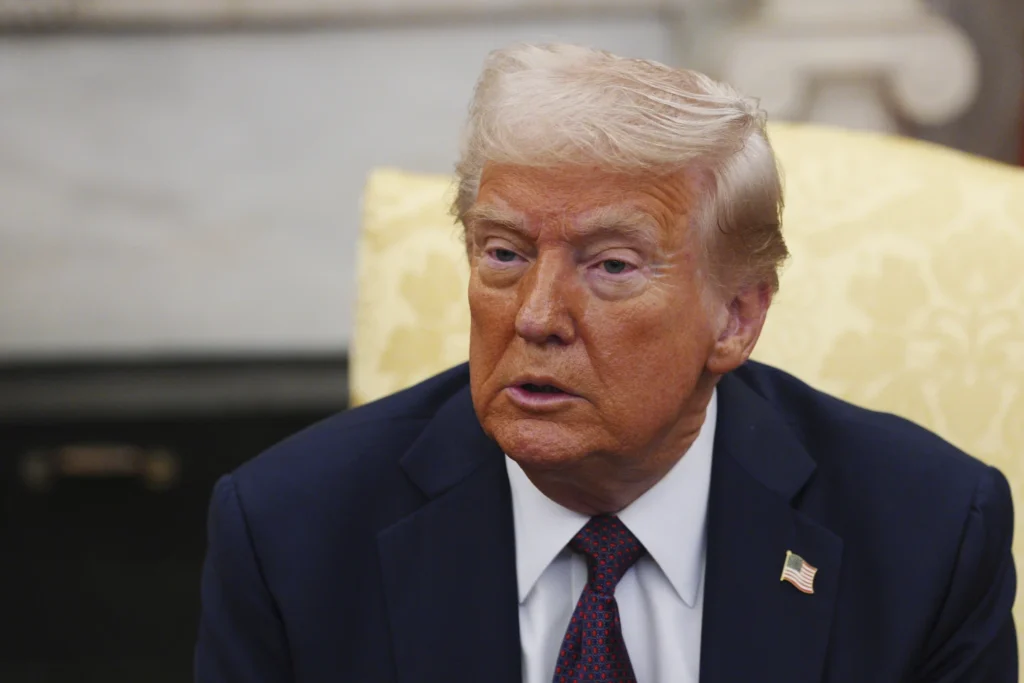President Donald Trump announced Monday that 25% tariffs on imports from Mexico and Canada will take effect Tuesday, igniting fears of a renewed North American trade war. The move, aimed at pressuring the U.S.’s two closest trading partners on border security and drug trafficking, also threatens to drive up inflation and disrupt supply chains.

“Tomorrow—tariffs 25% on Canada and 25% on Mexico. And that’ll start,” Trump told reporters in the Roosevelt Room. “They’re going to have to have a tariff.”
Trump has framed the tariffs as a way to push both nations to combat fentanyl smuggling and illegal immigration, but he has also pointed to economic goals, including reducing trade imbalances and encouraging factory relocations to the U.S.
His announcement rattled financial markets, with the S&P 500 dropping 2% in afternoon trading. The move underscores the political and economic risks Trump is willing to take, despite concerns over rising costs for businesses and consumers.
Commerce Secretary Howard Lutnick defended the tariffs, pointing to Taiwan Semiconductor Manufacturing Co. (TSMC) expanding its U.S. investment as an example of how the administration’s trade policies are attracting foreign investment.
Trump also reaffirmed that tariffs on Chinese imports, currently at 10%, will double to 20% on Tuesday.
In February, he granted Mexico and Canada a temporary reprieve after they pledged trade concessions. However, Trump made it clear Monday that there would be “no room left for Mexico or for Canada” to avoid the full 25% rate. Canadian energy products, including oil and electricity, will face a slightly lower 10% tariff.
“If Trump is imposing tariffs, we are ready,” said Canadian Foreign Minister Mélanie Joly. “We are ready with $155 billion worth of tariffs, and we’re ready with the first tranche of tariffs, which is $30 billion.”
Joly emphasized Canada’s commitment to maintaining a strong border plan, stating that diplomatic discussions with U.S. officials were ongoing.
Mexico’s President Claudia Sheinbaum acknowledged Trump’s authority over the decision but hinted at potential countermeasures.
“It’s a decision that depends on the United States government,” Sheinbaum said. “Whatever his decision is, we will make our decisions, and there is a plan—there is unity in Mexico.”
Both nations have taken action in response to Trump’s concerns. Mexico deployed 10,000 National Guard troops to its northern border to crack down on drug trafficking and illegal immigration. Canada appointed a fentanyl czar to address opioid smuggling, despite minimal evidence of fentanyl entering the U.S. from Canada.
Even as late as Sunday, Trump’s final decision on the tariffs remained uncertain. Lutnick described the situation as “fluid,” suggesting last-minute negotiations were still in play.
“He’s sort of thinking about right now how exactly he wants to play it with Mexico and Canada,” Lutnick said on Fox News’ “Sunday Morning Futures.” “And that is a fluid situation. There are going to be tariffs on Tuesday on Mexico and Canada. Exactly what they are, we’re going to leave that for the president and his team to negotiate.”
Treasury Secretary Scott Bessent revealed that Mexico had offered to impose 20% tariffs on Chinese imports as part of trade negotiations with the U.S.
Bessent also insisted that China, not U.S. businesses or consumers, would bear the cost of the tariffs. However, major companies like Ford and Walmart have warned about the potential impact on supply chains and consumer prices.
Economic studies from the Peterson Institute for International Economics and Yale University’s Budget Lab estimate that the average American family could see price increases exceeding $1,000 annually due to the tariffs.
“There’s no doubt this will have a disruptive effect on businesses,” said Eswar Prasad, an economist at Cornell University. “Companies will face supply chain disruptions, and inflationary pressures could increase.”
Prasad noted that a stronger U.S. dollar might offset some of the cost increases but could also make American exports less competitive, potentially widening the trade imbalance rather than reducing it.
Trump has also announced plans to introduce “reciprocal tariffs” in April, which would match the rates imposed by other countries, including adjustments for subsidies and value-added taxes.
Additionally, exemptions from Trump’s 2018 tariffs on steel and aluminum will be removed, with new tariffs set to hit industries such as automobiles, computer chips, copper, and pharmaceuticals.
As tensions escalate, all eyes will be on Mexico and Canada to see how they respond—and whether the U.S. economy can absorb the shock of Trump’s aggressive trade policies.



